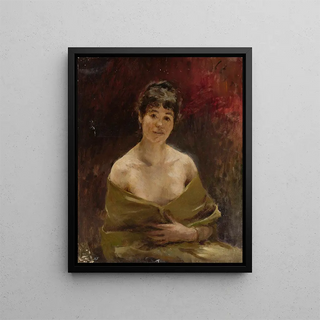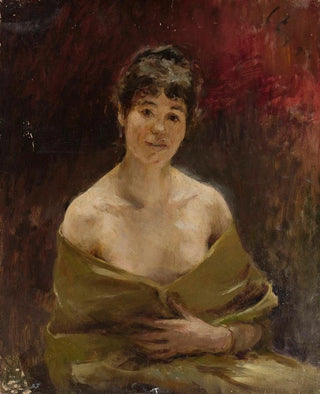Art print | Study of a female model in green drapery - Jan Cybis


View from behind

Frame (optional)
Jan Cybis's artwork "Study of a Female Model in Green Drapery" stands as a true ode to feminine beauty and artistic virtuosity. In this painting, the artist manages to capture the very essence of grace and elegance through the green drapery that envelops the model. This piece, both intimate and universal, invites viewers to contemplate not only the form but also the emotion it conveys. Light plays a crucial role, caressing the contours of the body and highlighting the textures of the fabric. Cybis, through his technical skill, succeeds in transcending a simple portrait to offer a genuine aesthetic experience.
Style and uniqueness of the work
Jan Cybis's style is characterized by exceptional finesse and meticulous attention to detail. In "Study of a Female Model in Green Drapery," he uses colors that are both rich and delicate, creating a contrast that immediately draws the eye. The drapery, both fluid and structured, seems almost alive, as if it breathes with the model. This approach demonstrates mastery of pictorial techniques reminiscent of the great masters of classical painting, while subtly incorporating modernity. Cybis manages to establish a dialogue between the past and the present, making this work timeless. The composition, balanced and harmonious, guides the viewer's gaze through the forms and shadows, revealing a depth that invites exploration.
The artist and his influence
Jan Cybis, an emblematic figure of 20th-century Polish art, has established himself through his unique style and his ability to capture human emotion. Born in a time when art was undergoing rapid change, he navigated between tradition and modernity, influenced by the artistic movements of his era. His training with renowned masters and his travels across Europe enriched his visual vocabulary, allowing him to broaden his expressive range. Cybis also played a crucial role in transmitting his knowledge, teaching many students and contributing to the vitality of art in Poland. His work, marked by keen sensitivity

Matte finish

View from behind

Frame (optional)
Jan Cybis's artwork "Study of a Female Model in Green Drapery" stands as a true ode to feminine beauty and artistic virtuosity. In this painting, the artist manages to capture the very essence of grace and elegance through the green drapery that envelops the model. This piece, both intimate and universal, invites viewers to contemplate not only the form but also the emotion it conveys. Light plays a crucial role, caressing the contours of the body and highlighting the textures of the fabric. Cybis, through his technical skill, succeeds in transcending a simple portrait to offer a genuine aesthetic experience.
Style and uniqueness of the work
Jan Cybis's style is characterized by exceptional finesse and meticulous attention to detail. In "Study of a Female Model in Green Drapery," he uses colors that are both rich and delicate, creating a contrast that immediately draws the eye. The drapery, both fluid and structured, seems almost alive, as if it breathes with the model. This approach demonstrates mastery of pictorial techniques reminiscent of the great masters of classical painting, while subtly incorporating modernity. Cybis manages to establish a dialogue between the past and the present, making this work timeless. The composition, balanced and harmonious, guides the viewer's gaze through the forms and shadows, revealing a depth that invites exploration.
The artist and his influence
Jan Cybis, an emblematic figure of 20th-century Polish art, has established himself through his unique style and his ability to capture human emotion. Born in a time when art was undergoing rapid change, he navigated between tradition and modernity, influenced by the artistic movements of his era. His training with renowned masters and his travels across Europe enriched his visual vocabulary, allowing him to broaden his expressive range. Cybis also played a crucial role in transmitting his knowledge, teaching many students and contributing to the vitality of art in Poland. His work, marked by keen sensitivity






